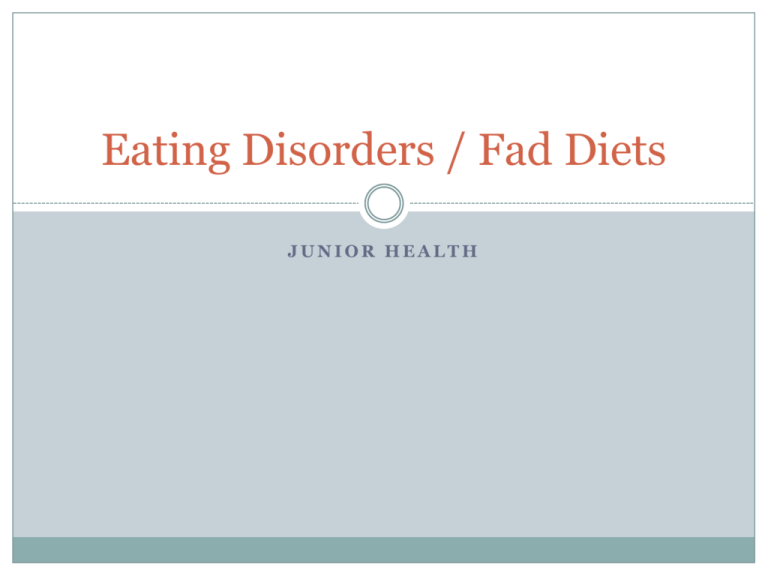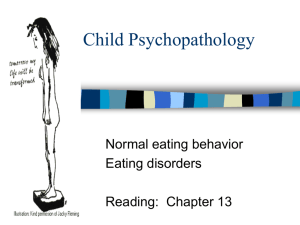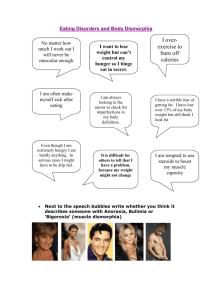Eating Disorders Notes
advertisement

Eating Disorders / Fad Diets JUNIOR HEALTH Eating Disorders Eating Disorders – extreme harmful eating behaviors that can cause serious illnesses or death. Types of Eating Disorders 1. Anorexia 2. Bulimia 3. Binge Eating Disorder (BED) Factors that contribute to Eating Disorders Psychological Factors – Interpersonal Factors – Social Factors – Biological Factors This is a list of famous people who have died from anorexia nervosa. Susan Peters - 23 October 1952, actress Karen Carpenter (American singer, The Carpenters) - died aged 32 from complications caused by anorexia.[1] Christy Henrich (American gymnast) - died in July 1994, aged 22, from complications caused by anorexia.[2] Lena Zavaroni - 1999 (35), vocalist Luisel Ramos - 2 August 2006, fashion model (22) Ana Carolina Reston (Brazilian model) - died 14 November 2006, aged 21, from complications caused by anorexia.[3] Eliana Ramos - 13 February 2007, fashion model (18) Hila Elmalich - 14 November 2007, fashion model (33) Isabelle Caro - 17 November 2010, fashion model, anorexia activist and actress (28) Heidi Guenther (American ballerina) - died aged 22, from complications caused by anorexia.[4] Michael Krasnow (American author) died October 1997, aged 28, author of My Life as a Male Anorexic.[5] Renée Vivien - 18 November 1909, poet (32) Anorexia Nervosa Is an eating disorder in which an irrational fear of gaining weight leads to self starvation. Four Primary Symptoms: 1. 2. 3. 4. Resistance Intense Denial ____________________in girls and women postpuberty (at least 3 consecutive periods) Warning Signs of Anorexia Dramatic ________. ___________________, food, calories, fat grams, and dieting. _________________, progressing to restrictions against whole categories of food (e.g. no carbohydrates, etc.). Frequent ________________or overweight despite weight loss. ________ about gaining weight or __________. Denial of hunger. Development of ________(e.g. eating foods in certain orders, excessive chewing, rearranging food on a plate). Consistent ____________________or situations involving food. Excessive, _________________-despite weather, fatigue, illness, or injury, the need to “burn off” calories taken in. __________________________and activities. Health Consequences Abnormally ___________and _____________, (heart muscle is changing) ________________risk rises as heart rate and blood pressure levels sink lower and lower. ___________ (reduction of bone density, dry, brittle bones) ___________and weakness. Severe __________ = ________________. Fainting, fatigue, and _________________. _____________, hair _____ is common. Growth of a downy layer of hair called lanugo all over the body, including the face, in an effort to keep the body warm. Bulimia Nervosa BULIMIA NERVOSA :. Bulimia includes -more than most people would eat in one meal--in short periods of time, then getting rid of the food and calories through vomiting, laxative abuse, or over exercising. Warning Signs of Bulimia Large amounts of food disappear in short periods of time or the existence of wrappers and containers indicating the consumption of large amounts of food. Evidence of _(frequent trips to the bathroom after meals, signs and/or smells of vomiting, presence of wrappers of laxatives or diuretics) _, rigid _(despite weather, fatigue, illness, injury; need to “burn off” calories taken in.) Unusual _. C on the back of the hands and knuckles from self-induced vomiting. Discoloration or s. L (make time for binge-and-purge sessions) Wi from friends and activities. Weight loss, dieting, and control of food behaviors become primary concerns. Health Consequences of Bulimia E that can lead to i and possibly h and d. Electrolyte imbalance is caused by dehydration and loss of p and s from the body as a result of purging behaviors. Inflammation and possible rupture of the e from frequent vomiting. T and staining from stomach acids released during frequent vomiting. Chronic irregular b and constipation as a result of laxative abuse. G is an uncommon but possible side effect of binge eating. Binge Eating Disorder Binge Eating Disorder is characterized by: . Health Consequences The health risks of BED are most commonly those associated with clinical obesity. Potential health consequences of BED include: Fad Diets Fad Diets – weight-loss plans that tend to be popular for a short time. They typically promise quick, easy weight loss. Weight Cycling – a repeated pattern of losing and regaining body weight. Types of Fad Diets Miracle Foods – these plans promise you can “burn fat” by eating lots of single food or type of food. Magic Combination – certain foods will trigger weight loss when eaten together. Liquid Diets – replace solid food with ultra-lowcalorie liquid formulas. Diet Pills – pills or supplements will suppress your appetite so that you eat less. Other claim to “Block” or “Flush” fat from body. Examples: Atkins, Cabbage, South Beach, Slim Fast, Stacker Pills 10 Characteristics of Fad Diets 1. Sounds too good to be true. 2. Promises weight loss without exercise. 3. Promises weight loss of more than 1 or 2 pounds per week. 4. Discourages drinking water. 5. Food or food groups are excluded or consumed excessively. 6. Lists “good” and “bad” foods. 7. Uses these terms:“Fat Burner,” “Fat Blocker,” or “Boost Metabolism.” 8. Includes no warnings related to possible medical problems. 9. Requires purchase of pills, bars, shakes, or other foods. 10. Claims specific food combinations have weight loss powers. I bought a refrigerator that makes an "oink" sound every time I opened the door. It made me hungry for pork chops. file:///Y:/Jr%20Health%20desktop%20June13/Eati ng%20Disorders/5%20Ways%20to%20Spot%20a% 20Fad%20Diet.htm







